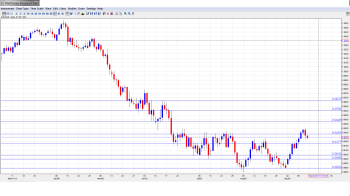AUD/USD posted some strong gains, but gave most of those up closed the week with modest gains. The pair ended the week at 0.9243. This week’s key release is the RBA Monetary Policy Meeting Minutes. Here is an outlook of the events and an updated technical analysis for AUD/USD.
It wasn’t a very good week for either the US or Australian releases. Australia’s Employment Change slumped to a five-month low, while in the US, retail sales and consumer confidence looked sluggish.
[do action=”autoupdate” tag=”AUDUSDUpdate”/]AUD/USD graph with support and resistance lines on it. Click to enlarge:
- RBA Monetary Policy Meeting Minutes: Tuesday, 1:30. Analysts will be paying close attention to this release, which is the key event of the week. The minutes will provide details of the RBA’s last policy meeting, at which time the central bank held interest rates at 2.50%. A report which is more hawkish than expected is bullish for the Australian dollar.
- New Motor Vehicle Sales: Tuesday, 1:30. New Motor Vehicle Sales measure the change in the purchase of cars and trucks. The indicator provides an important snapshot of consumer confidence and spending, which are critical for economic growth.
- CB Leading Index: Wednesday, 00:00. This indicator is based on 7 economic indicators. The July reading of -0.2% was a disappointment, as it marked the indicator’s first decline this year. The markets are hoping for a gain in September.
- RBA Assistant Governor Malcolm Edey Speaks: Wednesday, 1:30. Edey will address a financial forum in Sydney. Analysts will be looking for clues as to the RBA’s future monetary policy.
- RBA Bulletin: Thursday, 1:30. This is a minor event, as most of the information has been released previously. The markets will be focusing on the part of the bulletin which contains an analysis of current and future economic conditions.
* All times are GMT
AUD/USD Technical Analysis
AUD/USD started the week at 0.9190 and dropped to a low of 0.9167, breaking through support at 0.9180 (discussed last week). The pair then climbed sharply, breaking past the 0.93 line and touching a high of 0.9354. AUD/USD was unable to hold onto these gains and closed the week at 0.9243.
Live chart of AUD/USD: [do action=”tradingviews” pair=”AUDUSD” interval=”60″/]
Technical lines from top to bottom:
We start with resistance at 0.9670. This line was a cap for the pair in late May.
0.9556 has provided resistance since mid-June. At that time, AUD/USD went on a spiral that saw it drop below the 0.92 line.
0.9428 had played a support role since late 2011, but was breached in June and has provided strong resistance since then.
0.9283 saw a lot of action in the months of June and July, alternating between resistance and support roles. It starts off the week as weak resistance and could face strong pressure if the Aussie pushes higher.
0.9180 continues to provide support. This line was breached early in the week, but AUD/USD recovered and it continues in a support role.
0.9041 is the next support level. This line has seen activity in August and September, and is currently providing strong support.
The round number of 0.90 is next. This psychologically important level has some breathing room as the Aussie has posted strong gains since the beginning of the month.
0.8893 has been a steady support line since August 2010, as the Australian dollar put together a strong rally which saw it climb above the 1.10 line.
The final support line for now is 0.8747. This line has remained in place since July 2010.
I am bearish on AUD/USD.
The RBA has indicated that it would like a lower Australian dollar, so we could be due for a correction to the currency’s recent sharp gains. Over in the US, speculation about QE tapering continues, and uncertainty leading up to the FOMC Statement could lead investors to stick with the safe-haven US dollar.
The Aussie sometimes moves in tandem with gold. You can trade binary options on gold using this technical analysis.
Further reading:
- For a broad view of all the week’s major events worldwide, read the USD outlook.
- For EUR/USD, check out the Euro to Dollar forecast.
- For the Japanese yen, read the USD/JPY forecast.
- For GBP/USD (cable), look into the British Pound forecast.
- For USD/CAD (loonie), check out the Canadian dollar forecast.

